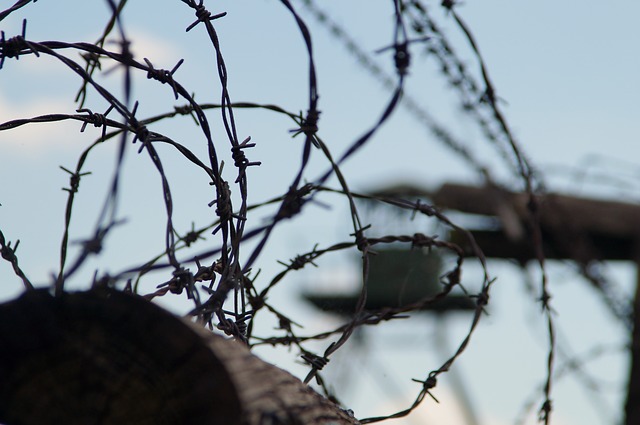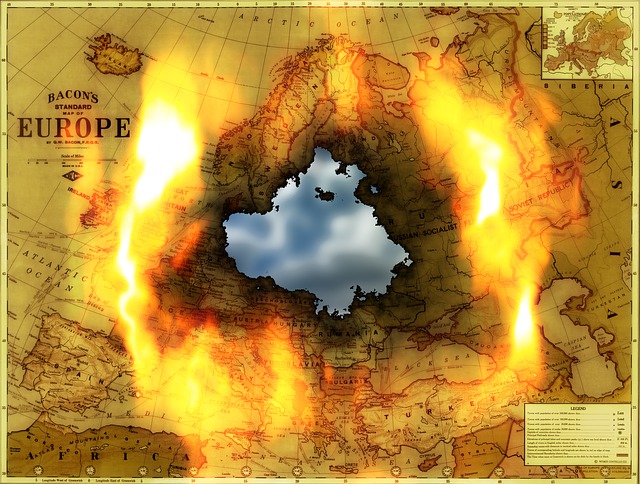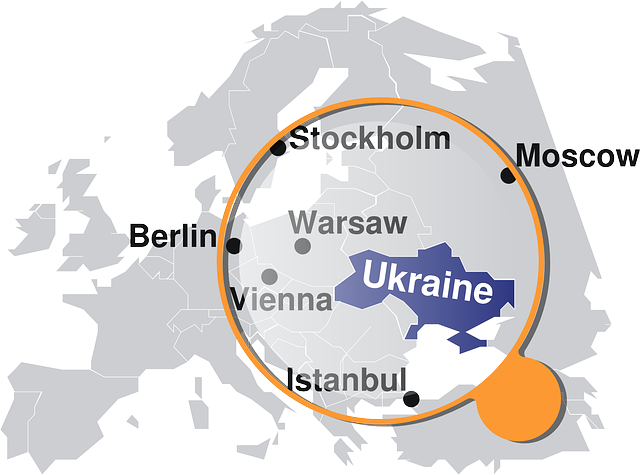11.719 Westquarter 77 EE (Earth Epic Calendar)
Soundtrack in my head: The Fixx, “Stand or Fall”

There is much talk of a new Cold War between the US and Russia. We are told that this new Cold War is due to Russian aggression. But a good diplomat must understand Russia’s history, their fears, and what they perceive to be their national interest. Our actions need to take into account possible Russian reactions to US actions and other world events, and then act accordingly in our best national interest.
I firmly believe that this particular new Cold War was completely avoidable. The US foreign policy of the 1990s can be described as a series of blown opportunities that could have made our current world much better than it is now, especially in the areas of war, peace, and the environment.
Understanding Russia
The first thing to understand about Russia is the remarkable difference between their geography and that of the United States. The US is separated from the world by two oceans which act as barriers. Canada has been a friendly neighbor to the north for most of US history and is currently a little more than one-tenth of the US population. Mexico to the south is a little more than one-third the population of the US, and US has dominated Mexico in many ways, The US has dominated many other of its neighbors to the south in similar ways.

By contrast, Russia has very few natural barriers between itself and potential invaders. Russia has been invaded many times throughout its history. Between the 13th and 17th centuries, the Mongols and Tatars engaged in multiple raids of Russia and Eastern Europe. The two most devastating invasions in Russian history came from Napoleon in 1812, and the German invasion in 1941, the latter of which resulted in the death of 26.6 million people. Neighboring countries also took over pieces of the crumbling Russian Empire during the Russian Revolution and Russian Civil War from 1917-22, with Japan occupying large parts of the Siberian Far East, and Germany taking over Belarus, Ukraine until its own loss in World War I.
Imagine what American foreign policy would be like if Mexico invaded the US and occupied a large swath of the American West, with tens of millions of Americans killed, until US troops managed to regroup after two years and beat back the invaders in a bloody, grinding war of attrition. And imagine what it would have been like for the US during the American Civil War if the British decided to ally with the Confederacy (which they almost did) and take back large parts of the Pacific Northwest while Mexico retook the American Southwest.
As someone with Lithuanian ancestry, I’m not going to defend Russia’s conquest of neighboring countries, any more than I’d defend the US conquest of hundreds of nations that were here before European settlement. I remember being shocked when a fourth grade teacher told me that Lithuania was not an independent country, and was elated when they won their independence in 1990-91, But Russia—particularly after the Napoleonic Wars and World War II, has been deeply paranoid about another invasion. That is a big reason why they established the Iron Curtain. As someone who also has Hungarian ancestry, I’m not going to defend it, but that was their thinking.
Stoking Russia’s fears
Fast forward to the fall of the Berlin Wall in 1989 and German reunification in 1990. We now know that Soviet Union President Mikhail Gorbachev was initially opposed to a reunited Germany, especially one existing entirely within the North Atlantic Treaty Organization (NATO). The Soviet Union had a legal right to reject any treaty of German reuinification but relented when Gorbachev received assurances from the US, Britain, France, and West Germany that NATO wouldn’t expand “one inch” beyond Germany.
President Bill Clinton could be argued as having started the new Cold War in 1994 when he decided to abrogate that understanding and advocate for expanding NATO eastward. He did so over the stringent objections of legendary diplomat and cold warrior George Kennan, who had been the architect of the “Russia containment policy” that sought to limit the reach of the Soviet Union. In a 1997 New York Times article, Kennan wrote:
“The view, bluntly stated, is that expanding NATO would be the most fateful error of American policy in the entire post-cold-war era. Such a decision may be expected to inflame the nationalistic, anti-Western and militaristic tendencies in Russian opinion; to have an adverse effect on the development of Russian democracy; to restore the atmosphere of the cold war to East-West relations, and to impel Russian foreign policy in directions decidedly not to our liking.”
But in 1999, Poland, Hungary, and the Czech Republic joined NATO, followed by Bulgaria, Estonia, Latvia, Lithuania, Romania, Slovakia, and Slovenia in 2004. Albania, Croatia, and Montenegro more recently joined. Note that Latvia and Lithuania were part of the former Soviet Union. And currently, NATO is talking about adding two other former Soviet republics as members—Ukraine and Georgia—as well as North Macedonia and Bosnia-Herzegovina. Presidents Yeltsin and Putin have complained about this NATO about-face.
As someone with Lithuanian heritage, I agree that it’s legitimate for the Baltic states, as well as Ukraine and Georgia and any other former Soviet republic to fear that a nationalist government in Russia might be tempted to try to take back what they consider to be “their” territory. All of these nations have their own unique cultures and histories, and Russian dominance of these areas goes back centuries. The Baltic states, in particular, are about as Russian as Sweden is. But it would have been far better to negotiate security guarantees between Russia, the Baltic States, Poland and other interested parties rather than inflame Russian fears by drawing the NATO encirclement even tighter around Russia.
Further humiliation of Russia occurred when US intervention in Russia’s 1996 elections elevated Boris Yeltsin over his opponents in a decisive way. The incumbent Yeltsin’s popularity had been in the single digits, but he won with a reported 54% of the vote. This was achieved through emergency IMF loans arranged by President Clinton, and heavy campaign involvement by campaign strategists that had worked for former California governor Pete Wilson. This effort was even openly reported by Time.
Ukraine

The history of the relationship between Ukraine and Russia is complicated. Kyivan Rus’ was a federation of peoples from 882-1240 CE that had Kyiv (now part of Ukraine) as its capital. Russia, Belarus and Ukraine consider Kyivan Rus’ to be the cultural ancestors of these respective modern nations. After the nation declined, the territory of Ukraine was divided, fought over and ruled over by many neighboring powers, including Lithuania, Poland, Austria-Hungary, the Ottoman Empire, and Russia. Nationalist sentiments aimed towards the restoration of the Ukrainian nation surfaced in the 19th century. Ukrainians fought on both sides of World War I as Ukrainian territory was split between the Russian and Austro-Hungarian Empires.
It could be argued that the current conflict between citizens of eastern and western Ukraine have roots going back at least a century. A series of conflicts known as the Ukrainian War of Independence ensued from 1917-20. After the collapse of the Russian Empire, an autonomous Ukrainian People’s Republic was declared in Kyiv in November 1917 by people from a wide variety of political persuasions. . But in December 1917, a rival government, the Ukrainian People’s Republic of Soviets was declared by Bolsheviks in Eastern Ukraine. After numerous military conflicts throughout Ukraine, the Bolsheviks in Eastern Ukraine prevailed by 1922.
While the number of Ukrainian universities and schools grew in the early years of the Soviet Union, people accused of having “Ukrainian nationalist bias” were purged from the Communist Party of Ukraine in the 1920s. The country suffered miserably under Stalin’s efforts, when millions of Ukranians died under Stalin’s repression and the resulting famine.
Years after the famine and World War II, Soviet leader Nikita Khrushchev transferred the Crimean Oblast from the Russian Soviet Republic to the Ukranian Soviet Republic. There is significant debate as to why Khrushchev did this. Khrushchev, though Russian, lived in Ukraine for part of his childhood and returned to Ukraine when Stalin appointed Khrushchev as the head of the Ukrainian Communist Party. So perhaps significant connections with Ukraine were a motivator, as well as the faxt that Crimea is geographically closer to Ukraine.
Post-independence Ukraine
Ukraine joined Russia and the other Soviet republics in declaring independence from the Soviet Union in 1991. Since independence, much of Ukrainian history resolves around the conflict between eastern and Western Ukraine. The ethnic breakdown of Ukraine as of 2001 was 77.8% Ukrainian and 13.4% Russian, but Ukrainians are much less of a majority in the eastern provinces of Ukraine, and are, in fact, a small minority in Crimea and Sevastopol.
Such conflicts between east and west in Ukraine have manifested at several points. The 2004 Ukrainian Presidential election, won by the Russia-leaning incumbent President Victor Yanukovych was marred by accusations of fraud, and an uprising known as the Orange Revolution combined with a no-confidence vote from the Ukrainian Parliament and election nullification by the Ukrainian Supreme Court resulted in a new election in which Europe-leaning Victor Yushchenko defeated Yanukovych 52% to 44%.
But power continued to shift back and forth between east and west. Europe-leaning Yulia Tymoshenko served as Prime Minister under Yushchenko, was ousted by Yanukovych in the 2006 parliamentary elections, but then returned as Prime Minister in snap 2007 elections. Yanukovych was elected President in 2010. Yanukovych has received outside support from Russian state media while Yushchenko and Tymoshenko have support from the more European-oriented western regions, as well as some support from foreign donors including the US State Department and USAID.
The 2014 Ukrainian Revolution drove Yanukovych out of Ukraine. While the revolution undoubtedly had popular support, some allege that this was at least partially orchestrated by the US State Department, with evidence being a leaked phone call between Victoria Nuland, Asst. Sec. of State for Europe, and Geoffrey Pyatt, the US Ambassador to Ukraine in which they are allegedly picking the new members of the new Ukrainian government.
Upon Yanukovych’s ouster, protests immediately arose in southern and eastern Ukraine and Crimea. Five days later, Russian special forces seized government buildings in Crimea. In the subsequent weeks, a referendum on Crimea’s status reportedly voted in favor of independence.
The integrity of the referendum has been questioned, especially with the presence of Russian special forces. Shortly thereafter, Crimea and Sevastopol (part of Crimea in the Ukraine, but treated separately in Russia) were approved by the Russian Duma as becoming part of Russia.
I am deliberately trying not to take sides as to whether the 2014 change in the Ukrainian government was a revolution or a coup, and I also don’t wish to take sides as to whether Crimea’s separation from Ukraine and incorporation into Russia represented the will of the Crimean people. According to the 2001 census, Crimea is 77% Russian speaking and Sevastopol is 90.6% Russian speaking. But the presence of Russian special forces calls into the question of the legitimacy of the referendum and subsequent incorporation into Russia.
But the proportional difference in population between Ukraine and Russia is similar to that of Mexico and the United States. This begs the question how the US would likely react if Russia tried to influence Mexican elections in order to install a government more friendly to Russia. Without a doubt, the US would intervene.
Khrushchev likely viewed his transfer of Crimea to Ukraine as a symbolic gesture. He certainly had no way of knowing that his decision would be part of a political crisis 60 years later as he would have never imagined the Soviet Union breaking up. For centuries, Crimea has hosted Russia’s only warm-water naval base. A post-Soviet agreement between Russia and Ukraine permitted Russia to continue to station its Black Sea Fleet in Crimea, but after Yanukovych fled to Russia, Russia might have questioned to what extent they could rely on Ukraine for this.
The point is that it is foolhardy to blame the Russians for the new Cold War and not consider the US’s own agression. US interference in Russia’s 1996 Presidential elections or NATO expansion beyond what had been agreed to are certainly precipitating events leading to the fallout of relations between the US and Russia.
It’s very sad that President Clinton blew a golden opportunity for greater cooperation between the US and Russia on the world’s problems of the day. The decision to pull the circle of NATO allies closer to Russia’s western front–where they had suffered two horrific invasions and wars of attrition in the 19th and 20th centuries—likely restarted the Cold War from Russia’s point of view.

One thought on “origin of the new Cold War with Russia”